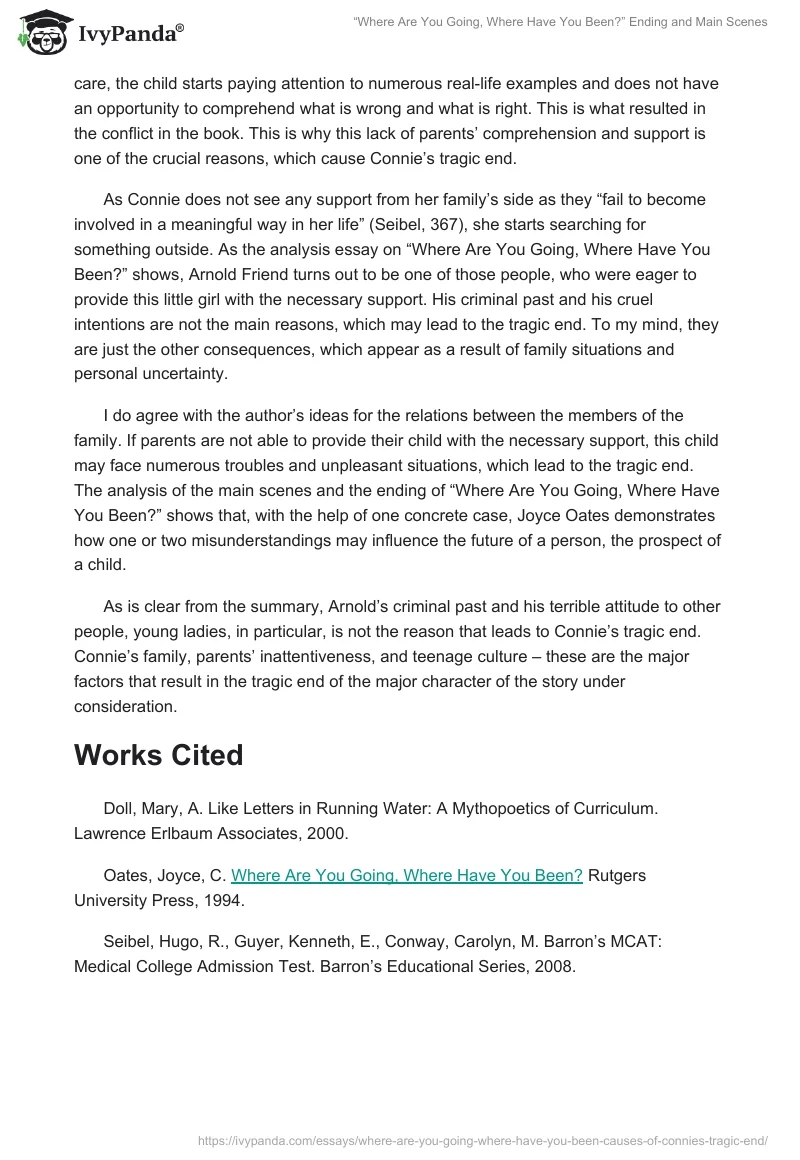Joyce Carol Oates is considered to be one of the most captivating authors. Her novels and short stories introduce numerous themes, which are significant for both men and women of any age. Her “Where Are You Going, Where Have You Been?” was written in the 1960s as a kind of response to the events in Arizona, connected to the times, when one man raped and killed several girls. This essay shall analyze the main scenes and the ending of “Where Are You Going, Where Have You Been?”
This is why realism and real-life cruelty are the things, which are inherent to this story and turn out to be significant points for any time. The main character in “Where Are You Going, Where Have You Been?”, Connie, is a 15-year-old girl, and Arnold Friend, the antagonist, is an adult man. The interactions, which happen between Arnold Friend and Connie and several rather provoking moments connected with Connie’s young age, immaturity, and her family’s lack of understanding, lead the story and Connie’s life to a tragic end.
Lots of students and ordinary readers find “Where Are You Going, Where Have You Been?” as an educative story that “captures so well their sense of rebellion against their patriarchal mothers, in particular, and family and society in general” (Doll, 94). Lots of young girls try to become independent earlier than it is possible. They try to pay the attention of other people to their appearance, their hair cut, and their style, but they do not comprehend that their behavior is not that appropriate.
What happens to Connie in “Where Are You Going, Where Have You Been?”?Connie faces specific problems within her own house: her mother cannot comprehend her daughter’s intentions and always compares her with her sister. The mother does not want to search for the necessary way to help her daughter; she just let Connie be more closely to the cultural phenomenon and be under threat to choose the wrong way. “She was fifteen and she had a quick, nervous giggling habit of craning her neck to glance into mirrors or checking other people’s faces to make her own was all right” (Oates, 25).
To my mind, this very age requires thorough attention from the parents’ side: a child should feel her relatives’ care and support. If there is no chance to find such kind of care, the child starts paying attention to numerous real-life examples and does not have an opportunity to comprehend what is wrong and what is right. This is what resulted in the conflict in the book. This is why this lack of parents’ comprehension and support is one of the crucial reasons, which cause Connie’s tragic end.
As Connie does not see any support from her family’s side as they “fail to become involved in a meaningful way in her life” (Seibel, 367), she starts searching for something outside. As the analysis essay on “Where Are You Going, Where Have You Been?” shows, Arnold Friend turns out to be one of those people, who were eager to provide this little girl with the necessary support. His criminal past and his cruel intentions are not the main reasons, which may lead to the tragic end. To my mind, they are just the other consequences, which appear as a result of family situations and personal uncertainty.
I do agree with the author’s ideas for the relations between the members of the family. If parents are not able to provide their child with the necessary support, this child may face numerous troubles and unpleasant situations, which lead to the tragic end. The analysis of the main scenes and the ending of “Where Are You Going, Where Have You Been?” shows that, with the help of one concrete case, Joyce Oates demonstrates how one or two misunderstandings may influence the future of a person, the prospect of a child.
As is clear from the summary, Arnold’s criminal past and his terrible attitude to other people, young ladies, in particular, is not the reason that leads to Connie’s tragic end. Connie’s family, parents’ inattentiveness, and teenage culture – these are the major factors that result in the tragic end of the major character of the story under consideration.
Works Cited
Doll, Mary, A. Like Letters in Running Water: A Mythopoetics of Curriculum. Lawrence Erlbaum Associates, 2000.
Oates, Joyce, C. Where Are You Going, Where Have You Been? Rutgers University Press, 1994.
Seibel, Hugo, R., Guyer, Kenneth, E., Conway, Carolyn, M. Barron’s MCAT: Medical College Admission Test. Barron’s Educational Series, 2008.


